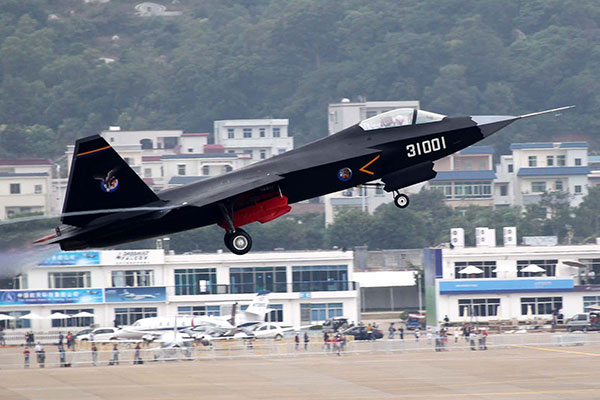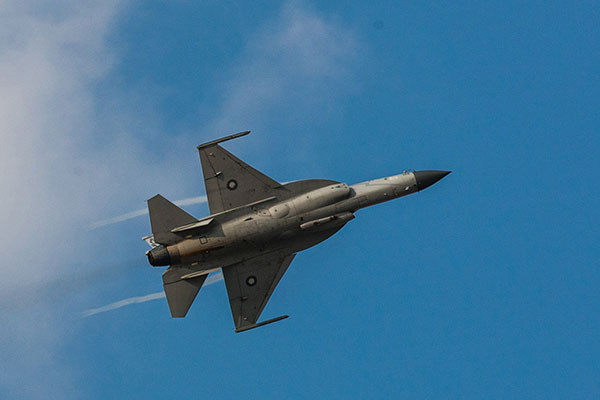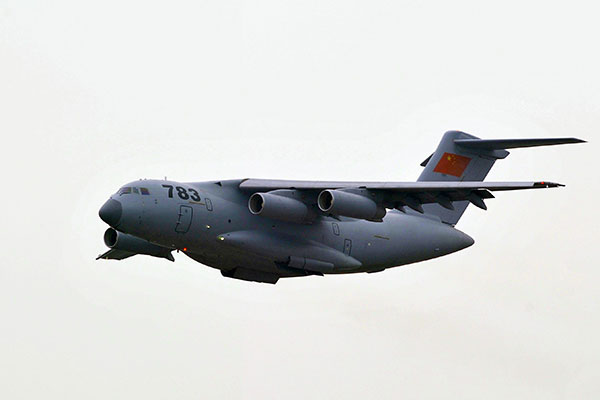
A J-31 stealth fighter takes off on a test flight ahead of the China International Aviation and Aerospace Exhibition in Zhuhai, Guangdong province. The Sino-Pakistani JF-17 Thunder is one of the cornerstones of Pakistan’s air force.[Photo/Provided to China Daily]
If the Aviation Industry Corp of China had announced 10 years ago that it wanted to compete with Western or Russian aviation giants such as Lockheed Martin and Sukhoi, its aspirations would have been dismissed as a daydream.
Now, although the company’s grand goal has yet to be fully realized, observers will have no doubts that AVIC is serious about its ambitions, especially after seeing the results of the company’s past decade of effort.
The hundreds of thousands of aviation enthusiasts and professionals that attended the 10th China International Aviation and Aerospace Exhibition in Zhuhai, Guangdong province, in mid-November, were treated to dazzling displays by AVIC’s new aircraft.
Air Commodore Khalid Mahmood of the Pakistani Air Force was among the crowd at the event, often known simply as Airshow China, and watched a flypast by the J-31 Gyrfalcon, a twin-engine, fifth-generation, radar-evading plane.
“The past 15 years have been very fruitful for the Chinese aviation industry, and now we have seen the results,” Mahmood said, as the stealth jet’s turbofans deafened the observers below.
“I’m a professional in this field, so I can tell you that the J-31 is a next-generation aircraft, and that no one else in the world has made as much progress as quickly as AVIC.”
In response to reports in the Indian media that Pakistan wants to buy two squadrons of J-31s, Mahmood said he was unaware of any plans for the introduction of the aircraft, but he was confident that “any good thing China has will be shared with Pakistan”.
Pakistan has bought many Chinese-made military aircraft over the years, and the JF-17 Thunder, one of the most advanced fighter jets in the country’s air force, was jointly developed by AVIC and the defense contractor Pakistan Aeronautical Complex.

The Sino-Pakistani JF-17 Thunder is one of the cornerstones of Pakistan’s air force.[Photo/Xinhua]
Another foreign officer, who declined to give his name, said, “It’s amazing that the Chinese aviation industry has grown to a level where it’s competing with the global leaders.”
As he watched the J-31 flying overhead, the officer added, “The rapid development of China’s aviation industry in terms of aerodynamics, avionics and weaponry has taken the world by surprise.”
Li Yuhai, AVIC’s deputy general manager in charge of military aircraft, was delighted by the comments, and said the J-31 will become the sensible option for developing countries.
“The J-31 Gyrfalcon can compete with any other aircraft of its kind,” he told reporters at the show. “Since the very beginning of its development, we have aimed to use the plane to end the dominance of foreign nations in fifth-generation fighter jets, and one of the J-31’s variations will be specifically designed for export. It will be our trump card to tap the international market.”
Currently, the only production-ready, fifth-generation combat aircraft on the market is the United States’ Lockheed Martin F-35, and the US only allows it to be sold to its allies.
Sun Cong, chief designer of China’s latest stealth jet, said the instructions AVIC’s leaders gave to the developers were simple: Design an aircraft capable of besting the F-35.
The aviation industry was stunned in October 2012 when the J-31 made its maiden flight, because few people had expected China to develop another fifth-generation fighter after the J-20 stealth jet was unveiled in January 2011.
During the past two years, the J-31 has undergone a series of flight tests, which have led to some changes in design, according to aviation industry observers, who have been following the jet’s development closely.
Bright prospects
Wang Ya’nan, deputy editor-in-chief of Aerospace Knowledge, said potential clients for the J-31 would be the traditional buyers of Chinese aircraft, such as Pakistan and Venezuela.
Several nations in the Middle East are also seen as potential purchasers, because the jet will have been tested rigorously in China’s arid, sandy northwestern regions by the time it’s ready to come into service, Wang said, adding that AVIC would have little difficulty upgrading the aircraft’s sandproofing capabilities.
“I don’t think AVIC will set a very high price for the J-31, because the export of the jet would help the company seize a considerable share of the market, and establish a reputation for high-end military aircraft,” Wang said. “Moreover, orders from other nations would help to maintain the production line.”
Wang’s opinion was echoed outside China by Robert Farley, assistant professor at the Patterson School of Diplomacy and International Commerce at the University of Kentucky. He told The New York Times: “Pakistan, of course, would be a huge buyer. Several Latin American countries are recapitalizing their air forces. In the Middle East, there’s a lot of dissatisfaction with the US and US equipment. A cheaper Chinese stealth fighter could do well.”
Wang said the aircraft’s prospects are bright, but AVIC must do one thing before it can sign any contracts-it must persuade the People’s Liberation Army air force to accept the J-31, otherwise foreign militaries will lack confidence in it.
“The J-31 is undoubtedly a project on AVIC’s own account, so the PLA has apparently not made a decision about procuring it. I think an indigenous, reliable engine would be the key to the PLA’s acceptance,” he said, adding that AVIC is developing an advanced turbofan engine that is expected to be production-ready within five years at most.
Accessible option
Sun, the chief designer, told Xinhua News Agency that he hoped the PLA air force will pair the plane with other advanced fighter jets, and that the upgraded J-31 will become China’s next-generation aircraft-carrier-borne fighter jet.
Xu Yongling, a military aviation expert and former test pilot, said advanced combat aircraft made by Western countries are usually subject to strict technological and export controls, and as a result, they are very expensive. That makes Chinese-made jets, which will have superior capabilities and cost less, a good choice for developing nations.
Although some observers have said the jet’s design means it will be of limited use to the Chinese military, Cao Weidong, a researcher at the PLA Naval Military Studies Research Institute, said the aircraft could still stand a chance of serving as a carrier-borne fighter if the wings, landing gear, and engines were upgraded.
“Although the J-31 has a short flight range, its cutting-edge radar, avionics, and stealth technology will make it a suitable companion for the J-15. It would do a good job of staging first strikes.”
Yin Zhuo, a senior expert with the PLA navy, said that buying armaments from China offers developing nations an added bonus-a willingness to help them build their own defense industries.
“China doesn’t intend to just earn money from developing countries. We have sold them weapons and equipment, and taught them how to maintain those arms, and if they had the necessary capability, we were also willing to sell them an entire manufacturing facility.”
He said China has helped nations such as Pakistan and Indonesia to assemble Chinese weapons, which has enabled them to gradually acquire the ability to develop and produce their own armaments, and eventually establish relatively independent defense industries.
Xu Bangnian, a professor at the PLA Air Force Command Institute, said: “Even if the PLA air force and navy currently don’t need the J-31, the plane will still be very popular in the international military aircraft market because it’s really the only choice for affordable stealth aircraft.”
A HEAVYWEIGHT NEWCOMER

AVIC’s Y-20 Kunpeng, a four-turbofan strategic airlifter, could become one of the Chinese company’s main exports in years to come.[Photo/Xinhua]
A monster transporter plane was unveiled at the China International Aviation and Aerospace Exhibition. The Y-20 Kunpeng, a four-turbofan strategic airlifter made by the Aviation Industry Corp of China, is set to go on the market, although the People’s Liberation Army will be supplied before other customers.
Geng Ruguang, deputy general manager at AVIC, said that development work and tests on the Y-20 have been satisfactory, and added that the huge transporter plane will be available to customers soon. However, Geng declined to say if the company has received any orders from foreign buyers.
Tang Jun, chairman of Xi’an Aircraft Industry, the AVIC subsidiary that’s developing the Y-20, was more forthright. “We will develop a number of variations of the Y-20, and we are definitely going to export them,” he said. “But the final decision will be up to the related governments and military authorities.”
The plane made its maiden flight in January 2013, making China the third nation, after the United States and Russia, to develop a heavy-lift transporter such as the Y-20.
A PLA National Defense University study in July showed that the Chinese military needs at least 10 transport regiments and as many as 400 Y-20s to conduct operations in Asia.
The Y-20 has a maximum payload of 66 metric tons, and a maximum takeoff weight of more than 200 tons, according to military sources.
A technical evaluation by Aerospace Knowledge showed that when fully laden with fuel and carrying a payload of 51 tons, the Y-20 can fly as far as 5,200 km, meaning the plane is capable of reaching every part of Eurasia, the US state of Alaska, Australia, and North Africa.
Wang Ya’nan, the magazine’s deputy editor-in-chief, said many countries need large transporter planes, because aircraft of this type provide a strategic advantage in power projection.
“In a large-scale deployment, they would have to either make one trip with four small or medium-sized transporters, or have one transporter fly four times to ferry the same amount that can be carried by a heavy-duty airlifter in just one flight. Large transporters such as the Y-20 can enable a rapid and convenient way of projecting power.”
A number of geopolitical factors are also likely to help the Y-20.
“The US has sold its Boeing C-17 to India, so it’s unlikely to give it to Pakistan,” Wang said. “Frankly speaking, nations like Pakistan and some countries in South America can only look to China if they want strategic transporters.”
Wu Jian, a military observer in Shanghai, echoed Wang’s remarks, saying that Russia hopes its Ilyushin Il-476 will capture half of the market for transporters, but its outmoded design means it’s unable to carry certain types of modern weapons.
“The Il-476’s cargo cabin design was based on the size of weapons made in the 1960s and ‘70s, while today’s equipment is much larger,” he said, noting that the newly developed Y-20 can carry all types of modern equipment.
